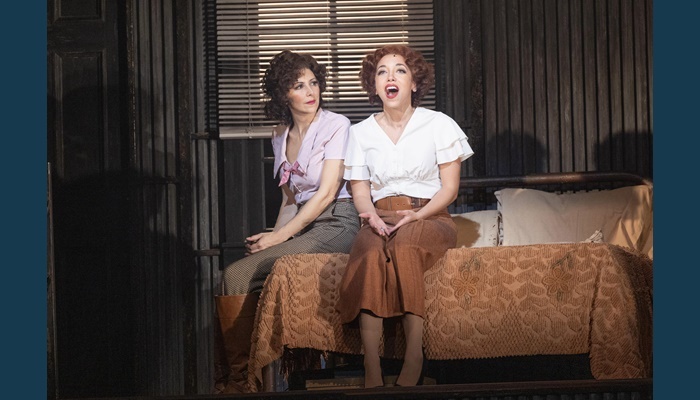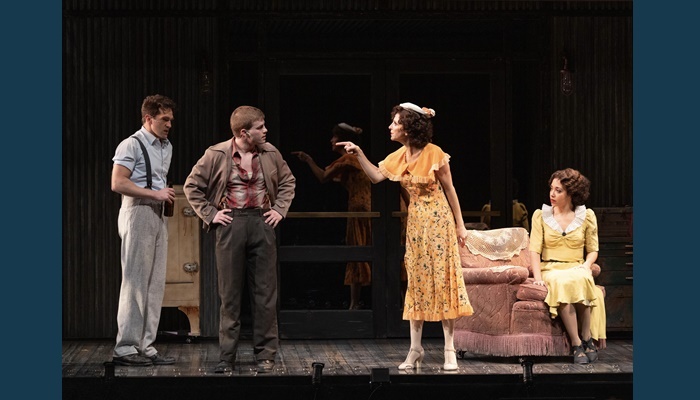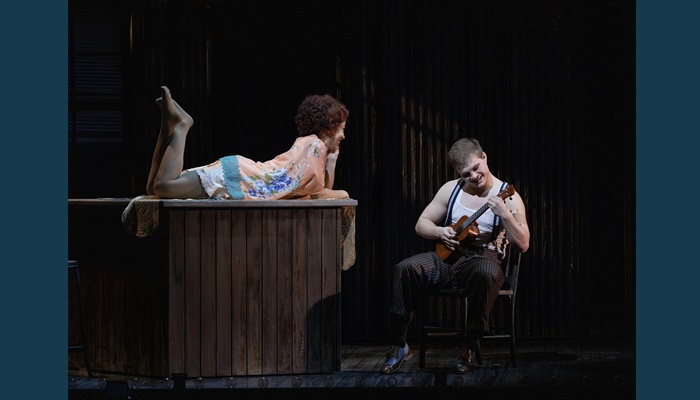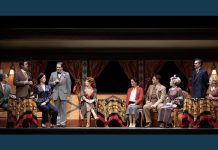SALT LAKE CITY, Utah, Feb. 29, 2024 (Gephardt Daily) — There’s a song lyric in “Bonnie & Clyde,” currently playing at Pioneer Theatre Company, in which Clyde sings: “I won’t get to heaven, why not raise a little hell?”
That’s kind of the backbone of the whole story; as Clyde goes on to sing in the song “Raise a Little Hell”: “All I did was rob a few stores/Justice here don’t fit the crime/I’ve been broken by the devil/Justice is a waste of time.”
The musical, which runs until March 9, shows the infamous outlaw couple as they descend into a life of crime, which as they go further and further, reaches a point of no return. And in the bleak, intense environment of America in the early 1930s, there’s a desperation to their world that really does beg the question, would you rather live fast and die young, or follow the rules and live a small, difficult, unremarkable life?
Debuting in 2009 at San Diego’s La Jolla Playhouse, “Bonnie & Clyde” had its Broadway premiere in 2011, followed by numerous notable productions around the world, including a recent West End revival. Pioneer’s production marks the first professional mounting of the show in Utah and is described as follows: “Adventure and romance await in the larger-than-life true tale of one of history’s most notorious couples. During the height of the Great Depression, Bonnie Parker and Clyde Barrow captured the nation’s imagination with their infamous rise from small-town West Texas nobodies to American legends. Featuring a book by Emmy nominee Ivan Menchell and a Tony-nominated score by composer Frank Wildhorn (‘Jekyll & Hyde,’ ‘The Count of Monte Cristo’) and Oscar and Tony Award-winning lyricist Don Black (‘Sunset Boulevard’), ‘Bonnie & Clyde’ is a celebration of quintessential American musical genres: blues, gospel, and rock ‘n’ roll. An electrifying story of fame, a life of crime, and love.”
I was surprised when I perused a handful of reviews of the other productions to see that some, particularly out of the U.K., were pretty scathing. Personally, I loved the piece, from start to finish. This version is a sensational spectacle, just like Bonnie and Clyde’s lives became, and a very memorable night out at the theater.

The mood is set right away as you enter the performance space and are greeted with a stunning set that depicts the front of a towering building made from corrugated iron, with giant mugshots of not just Bonnie and Clyde, but Blanche and Buck Barrow (Clyde’s brother and his wife), as well as giant letters, later illuminated in scarlet, that say “The Hideout.” The building looks industrial and depressed, but parts of it are adorned to resemble the front of a movie theater, suggesting the dichotomy of the world that Bonnie and Clyde lived in, with many Americans desperate to escape to a glamorous life, even if it was just on the silver screen. A movie theater-style marquee lights up to show different locations, from “First National Bank” to “The Woods” to “McLennan County Jail.” And adding to the feeling of pizzaz are a row of footlights that shine like diamonds and, as the show begins, spotlights that swirl around the stage. And with that dramatic beginning, we enter the sepia-toned world of “Bonnie & Clyde.”
I have to admit, there was a lot I didn’t know about the pair. Bonnie and Clyde’s exploits captured the attention of the American press and its readership during what is occasionally referred to as the “public enemy era” between 1931 and 1934. They are believed to have murdered at least nine police officers and four civilians; they were ambushed by police and shot to death in Louisiana, when Bonnie was just 23 and Clyde just 25. I also had no idea that Bonnie wrote poetry, and newspapers would hungrily print her words, further capulting them to fame. But I feel like one of the main aims of the musical is to show that beyond their infamy, they were really just human beings, as fallible as the rest of us. At one point, they bicker about whether they should be called Bonnie and Clyde or Clyde and Bonnie, they decide on the former because not much rhymes with the latter.
We first meet Bonnie and Clyde as children, as they sing about their aspirations with the older Bonnie and Clyde. We are then introduced to Bonnie as a feisty 20-year-old diner waitress who dreams of a life in pictures. Clyde, however, is dead set on becoming a notorious criminal, similar to Billy the Kid and Al Capone. Clyde, who has just broken out of prison with Buck, discovers Bonnie on the side of the road and they rapidly fall in love. Bonnie tells Clyde of her grand plans and he assures her that together they’ll make both their dreams come true. Clyde goes back to jail and is abused, leading him to turn to a makeshift weapon and perform his first murder. He convinces Bonnie to smuggle a gun into his cell, and Clyde again busts out of prison, this time killing a deputy. Just a side note by the way; it seems like it was exceptionally easy to break out of prison in the ’30s; it seems to happen an awful lot in this show.
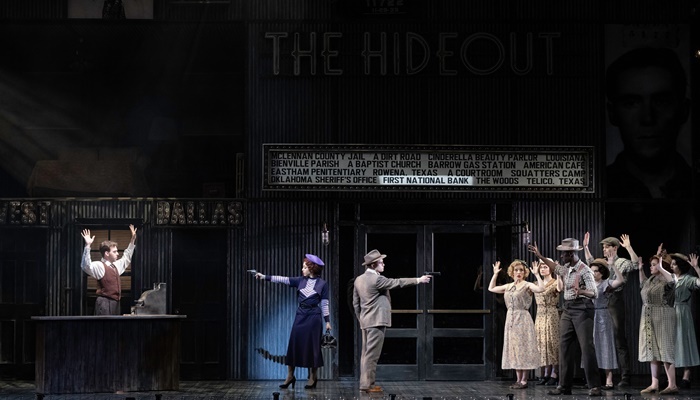
The second act then gains momentum as Bonnie and Clyde begin a life of crime, and achieve folk hero status throughout the country, with officers in every Southern state on the hunt for them.
The cast members, across the board, are outstanding. It’s worth the price of a ticket just to watch the stunning Alanna Saunders, who plays Bonnie and was last seen as Janet in “The Rocky Horror Show” in the fall. Saunders looks like a movie star of the period (she sings about wanting to be like Clara Bow, who she actually resembles, along with Corinne Griffith and Lupe Vélez) and is also extremely charismatic, with an X-factor that makes it hard to tear your eyes from her while she’s on stage. Her singing voice is rich and sumptuous, but also delicate and refined. She creates a character that is multi-layered and absolutely relatable; we see her gain confidence and step into her power as she realizes that she’s too far from what she has known to ever go back. I loved that her body language as the show progressed became more and more masculine; she even smokes a cigar at one point.
PTC newcomer Michael William Nigro plays Clyde with an exuberant hunger. He has an interesting energy onstage; he possesses an excellent, versatile singing voice, and both his singing and acting have a slightly untamed quality. This works well for Clyde, particularly in the standout song “When I Drive,” which sees him zooming around in an armchair that serves as a vehicle, pushed by Buck (Dan DeLuca).
The supporting cast also does a stellar job. DeLuca and Gina Milo as his wife Blanche are a nice counterpoint to Bonnie and Clyde, with Milo standing out particularly as the bravely devoted wife who won’t give up on her husband but yearns for a normal life. Utah actors are also well represented in this show, which I always like to see, with local favorite Mary Fanning Driggs playing Clyde and Buck’s mother Cumie, and Daniel Simons as their father Henry Barrow. We spoke to Driggs during rehearsals for “Bonnie & Clyde;” you can read that interview here.

The show is both directed and choreographed, with a sure and steady hand, by Gerry McIntyre, who creates a fun, exciting and inventive world onstage, particularly in the group numbers, while still managing to portray some of the darker themes that Bonnie and Clyde’s story illustrates, and which are still pertinent today, such as the pursuit of fame over everything and the role of the media in both building up public figures and tearing them down.
The production values are absolutely excellent. The lighting by José Santiago is moody and brooding, if lighting can be brooding, in primarily sepia tones with the sporadic use of crimson in the more dramatic moments. Spotlights and smoke are used effectively to heighten the mood. The costumes, by K.L. Alberts, in his 46th show for PTC, are beautiful. Alberts uses a muted palette of mostly grays, blues and browns, for the men, and the poorer characters, with splashes of pastel for some of the slightly more-well-to-do ladies, including Blanche. Bonnie is also dressed in more muted tones at the beginning, then her wardrobe gets more bold and elegant, with ensembles in rich hues including red and purple, suggesting the regality she has assumed. The latter costume, a dress with horizontal stripes on the arms and a chevron stripe on the chest, is an exact replica of one that the real Bonnie wears in the vast majority of photos of her, paired with her signature beret. It’s also worth mentioning that the hair and makeup design, by Tami Lee Thompson, is flawless.
The live orchestra is conducted with finesse by Tom Griffin; he is also musical director and plays keyboards, and the sound design is by Aaron Hubbard. The sound, generally, was just right, though I believe there was a small snafu right at the end of the show that made the ending seem a little sudden and less dramatic than it would have been with the appropriate effects. I’m sure that was ironed out by the next performance.
Overall, “Bonnie & Clyde” was a sizzling, uplifting night at the theater, and a fascinating exploration of the American dream and what it means; and in fact how similar it might have been in the 1930s and 90 years on, in 2024. In a way, nothing has changed. As the ensemble sings in “Made in America:” “We may be in debt/Wake up in a sweat/But let’s not forget/We were made in America.”
“Bonnie & Clyde” plays through March 9 at the Simmons Pioneer Memorial Theatre. Tickets are available here or by calling the box office at 801-581-6961.

